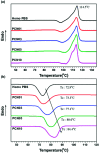Trans crystallization behavior and strong reinforcement effect of cellulose nanocrystals on reinforced poly(butylene succinate) nanocomposites
- PMID: 35539463
- PMCID: PMC9080038
- DOI: 10.1039/c8ra01868e
Trans crystallization behavior and strong reinforcement effect of cellulose nanocrystals on reinforced poly(butylene succinate) nanocomposites
Erratum in
-
Correction: Trans crystallization behavior and strong reinforcement effect of cellulose nanocrystals on reinforced poly(butylene succinate) nanocomposites.RSC Adv. 2018 Jun 13;8(38):21636. doi: 10.1039/c8ra90050g. eCollection 2018 Jun 8. RSC Adv. 2018. PMID: 35543991 Free PMC article.
Abstract
Biodegradable poly(butylene succinate) (PBS) nanocomposites are polymerized via in situ polymerization of succinic acid (SA) with cellulose nanocrystal (CNC)-loaded 1,4-butanediol (1,4-BD) mixtures. As reinforcement fillers, whisker-like CNCs are first dispersed in alcohol and sequentially spray-dried, before adding them to 1,4-BD. During the polymerization, the remains of sodium sulfonate in the CNC surfaces retard the polycondensation reaction, which is carefully controlled for the CNC-loaded systems. For the 0.1-1.0 wt% CNC-loaded PBS nanocomposites, it is found the nano-fillers are sufficiently dispersed to induce different crystallization behavior of the matrix polymer. The CNCs may initially act as heterogeneous nucleation sites of the molten PBS chains, during melt crystallization. In this case, most of them tend to be pushed out from the growing crystallites, which develop different nanocomposite morphologies with increasing CNC content. Among the resulting nanocomposites, the 0.1 wt% CNC-loaded system shows the highest tensile strength of 65.9 MPa, similar to that of nylon 6, as a representative engineering polymer as well as 2 fold elongation at break compared with Homo PBS. The in situ polymerized CNC-loaded PBS nanocomposites are expected to be a 100% biomass material for a virtuous cycle of biorefinery. Moreover, they demonstrate that the CNC-loaded PBS nanocomposite with a low CNC loading content can be used in various commercial applications for pollution abatement.
This journal is © The Royal Society of Chemistry.
Conflict of interest statement
There are no conflicts to declare.
Figures











Similar articles
-
Morphology, crystallization and rheological behavior in poly(butylene succinate)/cellulose nanocrystal nanocomposites fabricated by solution coagulation.Carbohydr Polym. 2017 May 15;164:75-82. doi: 10.1016/j.carbpol.2017.01.089. Epub 2017 Jan 25. Carbohydr Polym. 2017. PMID: 28325346
-
Combined effect of cellulose nanocrystals and poly(butylene succinate) on poly(lactic acid) crystallization: The role of interfacial affinity.Carbohydr Polym. 2018 Jan 1;179:79-85. doi: 10.1016/j.carbpol.2017.09.077. Epub 2017 Sep 25. Carbohydr Polym. 2018. PMID: 29111073
-
Rheological Percolation of Cellulose Nanocrystals in Biodegradable Poly(butylene succinate) Nanocomposites: A Novel Approach for Tailoring the Mechanical and Hydrolytic Properties.Macromol Res. 2021;29(10):720-726. doi: 10.1007/s13233-021-9080-x. Epub 2021 Nov 5. Macromol Res. 2021. PMID: 34754287 Free PMC article.
-
Highly reinforced poly(butylene succinate) nanocomposites prepared from chitosan nanowhiskers by in-situ polymerization.Int J Biol Macromol. 2021 Mar 15;173:128-135. doi: 10.1016/j.ijbiomac.2021.01.102. Epub 2021 Jan 18. Int J Biol Macromol. 2021. PMID: 33476620
-
Effect of low loadings of cellulose nanocrystals on the significantly enhanced crystallization of biodegradable poly(butylene succinate-co-butylene adipate).Carbohydr Polym. 2019 Feb 1;205:211-216. doi: 10.1016/j.carbpol.2018.10.035. Epub 2018 Oct 16. Carbohydr Polym. 2019. PMID: 30446097
Cited by
-
Sustainable Chitosan-Dialdehyde Cellulose Nanocrystal Film.Materials (Basel). 2021 Oct 6;14(19):5851. doi: 10.3390/ma14195851. Materials (Basel). 2021. PMID: 34640253 Free PMC article.
-
Crystallization Behavior and Mechanical Property of Biodegradable Poly(butylene succinate-co-2-methyl succinate)/Cellulose Nanocrystals Composites.Polymers (Basel). 2024 Jun 19;16(12):1735. doi: 10.3390/polym16121735. Polymers (Basel). 2024. PMID: 38932085 Free PMC article.
-
Study on the Synthetic Characteristics of Biomass-Derived Isosorbide-Based Poly(arylene ether ketone)s for Sustainable Super Engineering Plastic.Molecules. 2019 Jul 8;24(13):2492. doi: 10.3390/molecules24132492. Molecules. 2019. PMID: 31288408 Free PMC article.
-
Graphene Oxide-Induced Interfacial Transcrystallization of Single-Fiber Milkweed/Polycaprolactone/Polyvinylchloride Composites.ACS Omega. 2020 Aug 27;5(35):22430-22439. doi: 10.1021/acsomega.0c02913. eCollection 2020 Sep 8. ACS Omega. 2020. PMID: 32923801 Free PMC article.
-
A Review on Current Strategies for the Modulation of Thermomechanical, Barrier, and Biodegradation Properties of Poly (Butylene Succinate) (PBS) and Its Random Copolymers.Polymers (Basel). 2022 Mar 3;14(5):1025. doi: 10.3390/polym14051025. Polymers (Basel). 2022. PMID: 35267848 Free PMC article. Review.
References
-
- Bautista M. Martínez de Ilarduya A. Alla A. Vives M. Morató J. Muñoz-Guerra S. Eur. Polym. J. 2017;6:329–342.
-
- Najafi N. Heuzey M. C. Carreau P. J. Compos. Sci. Technol. 2012;72:608–615. doi: 10.1016/j.compscitech.2012.01.005. - DOI
-
- Hwang S. Y. Yoo E. S. Im S. S. Polym. Degrad. Stab. 2009;94:2163–2169. doi: 10.1016/j.polymdegradstab.2009.09.009. - DOI
-
- Guo Y. Yang K. Zuo X. Xue Y. Marmorat C. Liu Y. Chang C. C. Rafilovich M. H. Polymer. 2016;83:246–259. doi: 10.1016/j.polymer.2015.12.012. - DOI
LinkOut - more resources
Full Text Sources
Research Materials

